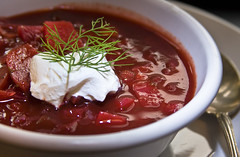
When the classic beet soup arrived at the table my brother complained “I don’t eat anything that ends in ‘scht.’” Borscht, a soup of Ukrainian origin, served hot or cold, is popular all over Eastern and Central Europe. How did it become Jewish?
Throughout history, Jewish people have absorbed and adapted the culinary traditions of the region they find themselves in. For example, around 1854 in France, Bines Lazard, a Jewish wine salesman, began selling macaroons in his shop, Maison Lazard. The macaroons were made from almonds, sugar and egg whites, and are sold today as macarons de Boulay, according to cookbook author Joan Nathan in “Quiches, Kugels, and Couscous: My Search for Jewish Cooking in France.”
Joseph Malin, a Jewish immigrant from Eastern Europe opened London’s first fish and chip shop in 1860 in the East End. Before then, chips (or what we Yankees call French Fries) had been found only in Irish potato shops.
Roman Jews had to make due with what they had, so they fried. A lot. Mostly fish, since that was available to them from a fish shop in the ghetto.
Nowadays, most Jewish foods can be classified as Sephardic or Ashkenazi. For example, during Hanukkah Ashkenazic Jews eat latkes (potato pancakes) and Sephardic Jews eat sufganiot (jelly doughnuts). Both of them stem from the tradition of eating foods fried in oil as a way to remember the miracle of the oil that lasted for eight days.
Culinary differences between Ashkenazic and Sephardic food are largely a result of where the two groups are from. Think about it – in the blazing heat of a Moroccan summer, a nice steamy bowl of matzo ball soup doesn’t sound quite so appetizing. Sephardic food tends to uses more spices, fish, and fresh fruits and vegetables, making for a bright and exciting meal. Ashkenazi food is more of what the Western world thinks of when they think of Jewish – it commonly includes includes heartier meats, pastries, breads, and potatoes.
The Jewish people are very connected to food, both in culture and religion. This is evident in most every Jewish community around the world – come Shabbat, you’re sure to find a communal meal. A Jew’s relationship with food and its symbolism starts at birth and continues throughout their life.
Benjamin Brasch is a third-year Journalism major at the University of Florida with minors in both Business Administration and Ethnomusicology. He is a massive foodie and fan of all types of music. He is obsessed with where food comes from, how ingredients are used, and what it takes to make a meal that changes people. He feels food can simultaneously put people in a different mood while fulfilling a basic physiological need. His column, Matzah Ballsy, appears here on alternating Fridays.
